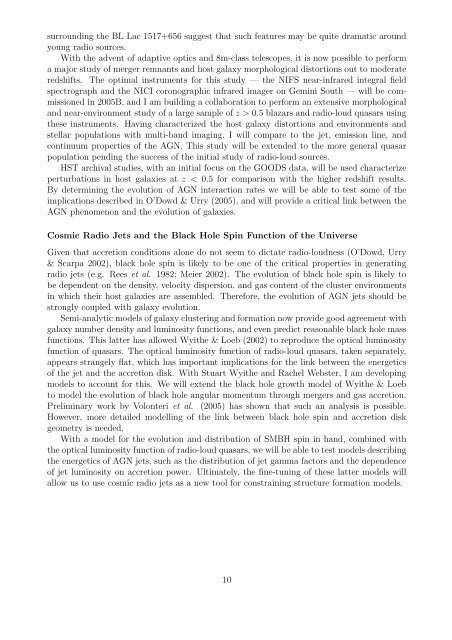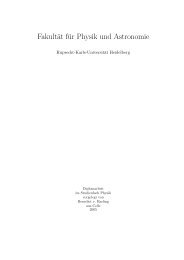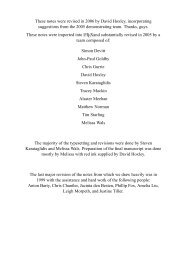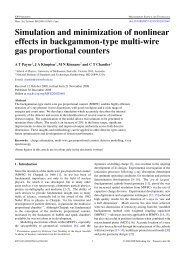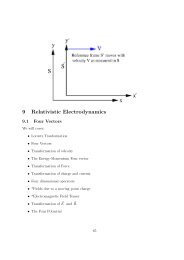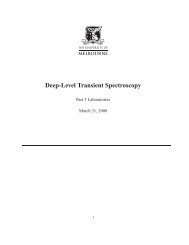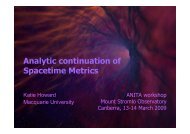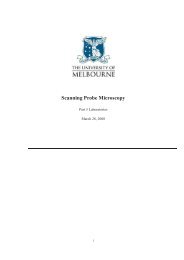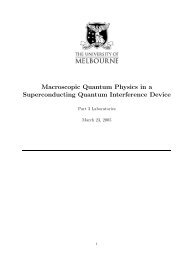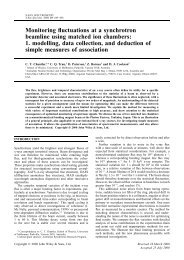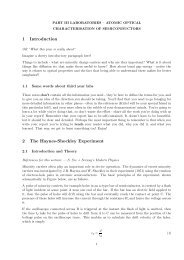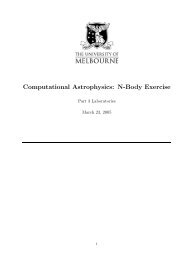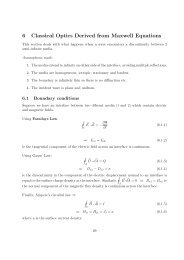Matthew John O'Dowd - School of Physics - University of Melbourne
Matthew John O'Dowd - School of Physics - University of Melbourne
Matthew John O'Dowd - School of Physics - University of Melbourne
Create successful ePaper yourself
Turn your PDF publications into a flip-book with our unique Google optimized e-Paper software.
surrounding the BL Lac 1517+656 suggest that such features may be quite dramatic around<br />
young radio sources.<br />
With the advent <strong>of</strong> adaptive optics and 8m-class telescopes, it is now possible to perform<br />
a major study <strong>of</strong> merger remnants and host galaxy morphological distortions out to moderate<br />
redshifts. The optimal instruments for this study — the NIFS near-infrared integral field<br />
spectrograph and the NICI coronographic infrared imager on Gemini South — will be commissioned<br />
in 2005B, and I am building a collaboration to perform an extensive morphological<br />
and near-environment study <strong>of</strong> a large sample <strong>of</strong> z > 0.5 blazars and radio-loud quasars using<br />
these instruments. Having characterized the host galaxy distortions and environments and<br />
stellar populations with multi-band imaging, I will compare to the jet, emission line, and<br />
continuum properties <strong>of</strong> the AGN. This study will be extended to the more general quasar<br />
population pending the success <strong>of</strong> the initial study <strong>of</strong> radio-loud sources.<br />
HST archival studies, with an initial focus on the GOODS data, will be used characterize<br />
perturbations in host galaxies at z < 0.5 for comparison with the higher redshift results.<br />
By determining the evolution <strong>of</strong> AGN interaction rates we will be able to test some <strong>of</strong> the<br />
implications described in O’Dowd & Urry (2005), and will provide a critical link between the<br />
AGN phenomenon and the evolution <strong>of</strong> galaxies.<br />
Cosmic Radio Jets and the Black Hole Spin Function <strong>of</strong> the Universe<br />
Given that accretion conditions alone do not seem to dictate radio-loudness (O’Dowd, Urry<br />
& Scarpa 2002), black hole spin is likely to be one <strong>of</strong> the critical properties in generating<br />
radio jets (e.g. Rees et al. 1982; Meier 2002). The evolution <strong>of</strong> black hole spin is likely to<br />
be dependent on the density, velocity dispersion, and gas content <strong>of</strong> the cluster environments<br />
in which their host galaxies are assembled. Therefore, the evolution <strong>of</strong> AGN jets should be<br />
strongly coupled with galaxy evolution.<br />
Semi-analytic models <strong>of</strong> galaxy clustering and formation now provide good agreement with<br />
galaxy number density and luminosity functions, and even predict reasonable black hole mass<br />
functions. This latter has allowed Wyithe & Loeb (2002) to reproduce the optical luminosity<br />
function <strong>of</strong> quasars. The optical luminosity function <strong>of</strong> radio-loud quasars, taken separately,<br />
appears strangely flat, which has important implications for the link between the energetics<br />
<strong>of</strong> the jet and the accretion disk. With Stuart Wyithe and Rachel Webster, I am developing<br />
models to account for this. We will extend the black hole growth model <strong>of</strong> Wyithe & Loeb<br />
to model the evolution <strong>of</strong> black hole angular momentum through mergers and gas accretion.<br />
Preliminary work by Volonteri et al. (2005) has shown that such an analysis is possible.<br />
However, more detailed modelling <strong>of</strong> the link between black hole spin and accretion disk<br />
geometry is needed.<br />
With a model for the evolution and distribution <strong>of</strong> SMBH spin in hand, combined with<br />
the optical luminosity function <strong>of</strong> radio-loud quasars, we will be able to test models describing<br />
the energetics <strong>of</strong> AGN jets, such as the distribution <strong>of</strong> jet gamma factors and the dependence<br />
<strong>of</strong> jet luminosity on accretion power. Ultimately, the fine-tuning <strong>of</strong> these latter models will<br />
allow us to use cosmic radio jets as a new tool for constraining structure formation models.<br />
10


